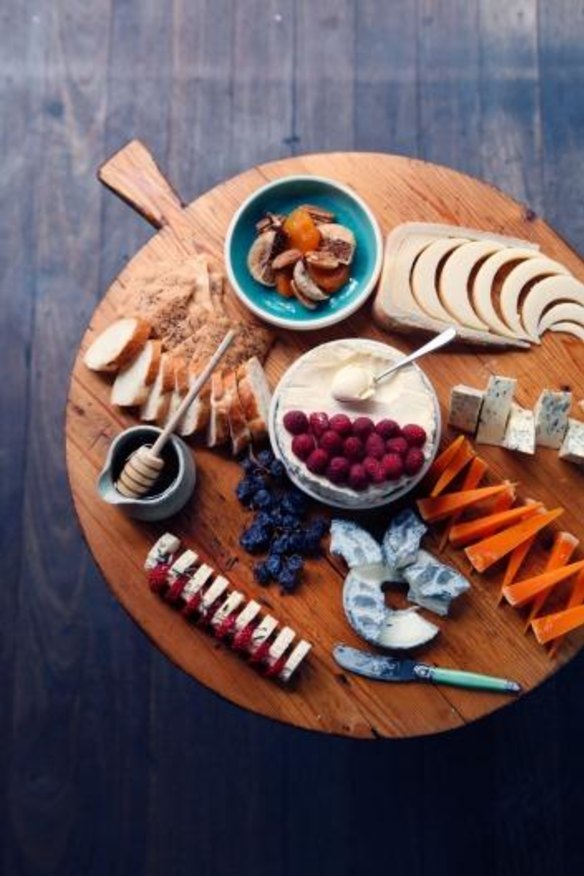How to serve cheese

What is the best thing to serve with cheese. Dried fruit? Crackers? H. Carmody
I remember hitchhiking around France in the early 1990s and ending up in an auberge outside of Lyon, talking schoolboy French with the owners' school-age children. After the main course I was offered the cheese board. A young hungry man and never having seen so much good cheese on the one half square metre before, I gorged myself. The hostess politely removed the board from under my drooling maw and passed it on to the other guests. The hosts served their cheese board with a little bread. Good cheese should be served with good bread. Both are products of fermentation and good bread has amino acids created by the yeast that enhances the flavour of amino acids created during the cheesemaking process – taste nerds call it umami synergy. Lavosh made from sourdough can be good but can break into little shards in the mouth, changing the mouthfeel. British cheesemonger Neal's Yard Dairy in London sells and recommends Scottish oatcakes and Irish brown bread crackers. Fruit, salad and other ornamentation, particularly in restaurants, gives visual bulk to the platter. Quince pastes can be overpowering with most cheeses but good with strong blue cheese. Cheese broadcaster Will Studd says crackers are served with cheese to disguise lesser-quality cheeses.
I used a supermarket-brand ground cinnamon to make my Christmas pudding this year and it tasted different. Why? B. Gillham
One of my bugbears is the substitution of true cinnamon, made from the bark of the Sri Lankan cinnamon tree Cinnamomum verum , with the bark of a cheaper close relative, the cassia tree, Cinnamomum cassia. Cassia bark is thicker, coarser and the ensuing ground spice, known as Dutch cinnamon, baker's cinnamon and even bastard cinnamon, has a bitter aftertaste. Ask to speak to the store manager for a refund.
As part of my new year's resolutions I want to eat more fibre. Can I substitute white flour with wholemeal flour? K. Collins
Generally, yes. Wholemeal flour contains the bran layers on the outside of the grain as well as the germ. The germ is the embryo of the seed and contains nutritious oils that can oxidise so are removed during milling to make white flour. Bran does rehydrate so you'll need to add a little more liquid than the recipe suggests, about 10 per cent, depending on what consistency the recipe calls for. As there is proportionally less protein per volume, if making bread you may want to work the dough less, so as not to overwork the gluten. Wholemeal flour is best suited to more rustic baking such as slices, bar cakes and muffins. If you want sponge cake with more fibre, eat lamingtons.
What causes the bubbles when you fry food? L. Knight
That's steam. Say the oil is 180C and water boils at 100C. Very soon after contact with the oil the water in the food boils, erupting as steam through the surface of the food and bubbling to the top of the oil. This outgoing pressure prevents the oil from penetrating the food. When the food cools and the steam inside the food condenses, the resulting vacuum draws oil into the food. In the case of battered food, such as deep-fried fish, it is the steam inside the crisping batter that cooks the fish, not the oil. So if one doesn't want to consume the oil, one simply removes the batter and eats the fish inside. As for the leftover batter, that is what seagulls are for.
Letters
Last year in this column we suggested to readers that to prevent rissoles from falling apart, they should mix or "knead" the meat for five to 10 minutes to bind the proteins together. One reader, L. Finch, had a problem with this. "When you are 87," wrote L. Finch, "see how you go at kneading anything for 5-10 minutes. At my age one is 'needing'." L. Finch, like many readers, suggested adding egg and flour to the rissole mixture and stirring a little with a wooden spoon. I suggest skipping the egg and flour and use a free-standing mixer to bind.
Send your vexing culinary conundrums to brainfood@richardcornish.com.au or tweet to @Foodcornish
The best recipes from Australia's leading chefs straight to your inbox.
Sign up